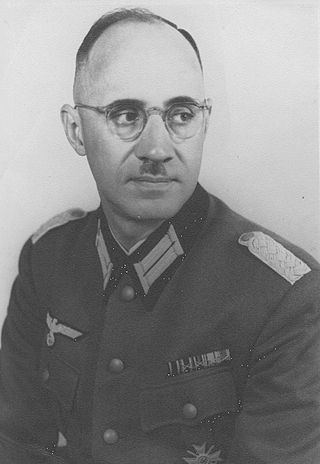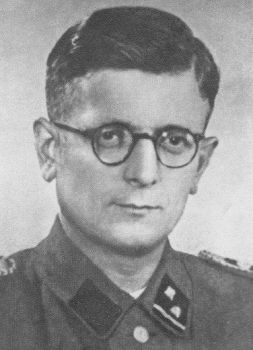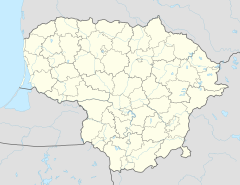
Vilnius is the capital and largest city located in Lithuania. As of January 2024, Vilnius' estimated population was 602,430, while the Vilnius urban area extends beyond the city limits and had an estimated population of 708,627.

Aukštieji Paneriai is a neighborhood of Vilnius, situated about 10 kilometres away from the city center. It is located on low forested hills, on the Vilnius-Warsaw road. Paneriai was the site of the Ponary massacre, a mass killing of as many as 100,000 people from Vilnius and nearby towns and villages during World War II.

Elektrit Radiotechnical Society was the largest privately owned company in Wilno, Second Republic of Poland (1925–39).

Karl Plagge was a German Army officer who rescued Jews during the Holocaust in Lithuania by issuing work permits to non-essential workers. A partially disabled veteran of World War I, Plagge studied engineering and joined the Nazi Party in 1931 in hopes of helping Germany rebuild from the economic collapse following the war. After being dismissed from the position of lecturer for being unwilling to teach racism and his opposition to Nazi racial policies, he stopped participating in party activities in 1935 and left the party when the war broke out.

The Vilna Ghetto was a World War II Jewish ghetto established and operated by Nazi Germany in the city of Vilnius in the modern country of Lithuania, at the time part of the Nazi-administered Reichskommissariat Ostland.

HKP 562 was the site of a Nazi forced labor camp for Jews in Vilnius, Lithuania, during the Holocaust. It was centered around 47 & 49 Subačiaus Street, in apartment buildings originally built to house poor members of the Jewish community. The camp was used by the German army as a slave labor camp from September 1943 until July 1944.
Ypatingasis būrys or Special Squad of the German Security Police and SD was a killing squad operating in the Vilnius Region in 1941–1944. The unit, primarily composed of Lithuanian volunteers, was formed by the German occupation government and was subordinate to Einsatzkommando 9 and later to Sicherheitsdienst (SD) and Sicherheitspolizei (Sipo).p.15 The unit was subordinated to German police, and had no official autonomy. In Polish they were colloquially called strzelcy ponarscy.

Anton Schmid was an Austrian Wehrmacht recruit who saved Jews during the Holocaust in Lithuania. A devout but apolitical Roman Catholic and an electrician by profession, Schmid was conscripted into the Austro-Hungarian Army during World War I and later into the Wehrmacht during World War II.

The Ponary massacre, or the Paneriai massacre, was the mass murder of up to 100,000 people, mostly Jews, Poles, and Russians, by German SD and SS and the Lithuanian Ypatingasis būrys killing squads, during World War II and the Holocaust in the Generalbezirk Litauen of Reichskommissariat Ostland. The murders took place between July 1941 and August 1944 near the railway station at Ponary, a suburb of today's Vilnius, Lithuania. 70,000 Jews were murdered at Ponary, along with up to 20,000 Poles, and 8,000 Soviet POWs, most of them from nearby Vilnius, and its newly formed Vilna Ghetto.

Martin Weiss was a German Nazi official and de facto commander of the Vilna Ghetto and a Holocaust perpetrator. He was also the commander of the notorious German - sponsored Ypatingasis būrys killing squad, which was largely responsible for the Ponary massacre where approximately 100,000 people were shot.

The military occupation of Lithuania by Nazi Germany lasted from the German invasion of the Soviet Union on June 22, 1941, to the end of the Battle of Memel on January 28, 1945. At first the Germans were welcomed as liberators from the repressive Soviet regime which had occupied Lithuania. In hopes of re-establishing independence or regaining some autonomy, Lithuanians had organized a a Provisional Government. It lasted six weeks.
The Šiauliai or Shavli Ghetto was a Jewish ghetto established in July 1941 by Nazi Germany in the city of Šiauliai in Nazi-occupied Lithuania during the Holocaust. The ghetto comprised two areas – one in the Kaukazas suburb and one on Trakai Street. Both were liquidated by July 1944, and their inhabitants were killed or transferred to Nazi concentration camps. In 1939, one quarter of the population of Šiauliai was Jewish, about 8,000 persons. By the end of World War II, only about 500 Jews of the city had survived.
Rachel Margolis was a Holocaust survivor, partisan, biologist and Holocaust historian.
The following is a timeline of the history of the city of Vilnius, Lithuania.
Švenčionys, Svintsyan or Święciany Ghetto was a Jewish ghetto in Nazi-occupied Švenčionys. It operated from July 1941 to April 1943. At its peak, the ghetto housed some 1,500 prisoners. It was located in what today is a city park; the location is marked by a wooden menorah carved by Juozapas Jakštas.
Jacob Gens was the head of the Vilnius Ghetto government. Originally from a merchant family, he joined the Lithuanian Army shortly after the independence of Lithuania, rising to the rank of captain while also securing a college degree in law and economics. He married a non-Jew and worked at several jobs, including as a teacher, accountant, and administrator.
Bruno Kittel was an Austrian Nazi functionary in the German SS and Holocaust perpetrator who oversaw the liquidation of the Vilna Ghetto in September 1943. Kittel became known for his cynical cruelty. He disappeared after the war.
Rudolf Neugebauer was a German SS Hauptsturmführer during the Nazi era. He served as the head of the Vilnius Gestapo in German-occupied Lithuania and personally killed Jacob Gens.












